Camping is a phenomenal way to unwind and disconnect from the fast-paced demands of everyday life. It provides an opportunity to truly immerse yourself in the serene embrace of nature, allowing for a complete rejuvenation of your mind, body, and soul. However, we understand that the idea of sleeping in a tent can be overwhelming for many individuals. The prospect of resting on the hard ground, with only a thin layer of fabric separating you from the elements, can indeed deter some from embracing this adventurous experience. But fear not, because we are here to guide you towards the most blissful and comfortable way to indulge in a restful slumber within the confines of a tent.
Choosing the Right Sleeping Gear
Selecting the ideal tent B.
When it comes to ensuring a comfortable night’s sleep in a tent, one of the most crucial aspects is carefully selecting the right sleeping gear. This includes not only your tent, sleeping bag, and sleeping pad, but also considering various factors that can greatly enhance your camping experience.
Furthermore, it’s essential to take into account the weather conditions of your camping destination. Selecting a tent that provides adequate protection against rain, wind, and extreme temperatures is key. Look for features such as a waterproof rainfly, sturdy tent poles, and a durable tent floor to keep you dry and sheltered during unexpected weather changes. Additionally, consider the ventilation options of the tent to prevent condensation build-up and ensure a comfortable sleeping environment.[3]
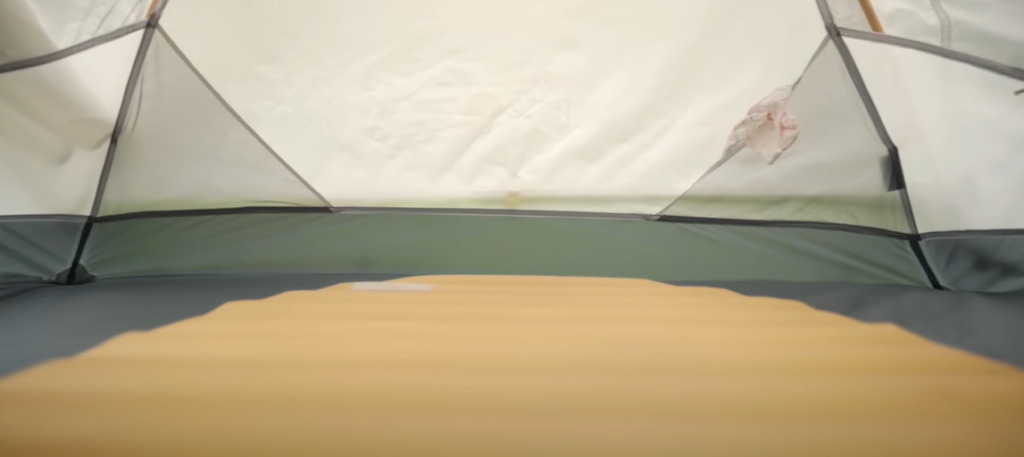
Sleeping bag options for maximum comfort
Next, we move on to the all-important sleeping bag. The key to a comfortable night’s sleep is selecting a sleeping bag that provides both insulation and ventilation. Depending on the temperature of your camping destination, choose between synthetic or down-filled sleeping bags. Synthetic bags are ideal for damp conditions as they retain their insulating abilities even when wet. On the other hand, down-filled bags offer superior warmth and are perfect for colder climates. Additionally, consider the shape of your sleeping bag – rectangular or mummy-shaped. Rectangular bags provide more room to move around, whereas mummy-shaped bags offer better heat retention.[3]
The importance of a quality sleeping pad
Last but certainly not least, let’s not forget the often-overlooked component of sleeping gear – the indispensable sleeping pad. A top-notch quality sleeping pad can truly make all the difference when it comes to ensuring a blissfully comfortable night’s sleep in the cozy confines of your tent. Not only does it provide essential cushioning and support for your tired body, but it also acts as a vital insulating layer, effectively shielding you from the chilly ground below. When it comes to selecting the perfect sleeping pad, be sure to consider key features such as thickness, weight, and the R-value (insulation level) as these crucial factors can undeniably have a significant impact on your overall comfort levels and the quality of your outdoor slumber. So, take the time to choose wisely and rest easy, knowing that you’re equipped with the ideal sleeping pad for your wilderness adventures.[3]
Sleep-Enhancing Accessories
Aside from the basic sleeping gear, there are a few additional accessories that can greatly enhance your overall comfort levels while sleeping in a tent. These include:
- Pillows: Instead of sacrificing comfort and just using a rolled-up jacket or clothes as a makeshift pillow, it is recommended to invest in a compact camping pillow. A camping pillow provides better neck support and improves sleep quality, allowing you to wake up feeling refreshed and ready for the day’s adventures.
- Eye mask and earplugs: These are essential for reducing distractions and promoting a more restful sleep, especially if you’re camping in a noisy or brightly-lit environment. An eye mask blocks out any unwanted light, helping you to fall asleep faster and stay asleep longer. Earplugs, on the other hand, minimize any disruptive noises, ensuring a peaceful and undisturbed slumber under the starry night sky.
- Headlamp: A headlamp is a versatile accessory that proves incredibly useful when you need to navigate your way around the tent at night without disturbing your fellow campers. With a headlamp, you can easily find your belongings, locate the zipper on your tent, or safely make your way to the restroom facilities. Additionally, a headlamp is also convenient for reading before bed, allowing you to indulge in your favorite book without the need for external lighting.[1]
By considering these additional accessories, you can elevate your camping experience and create a cozy and comfortable sleeping environment in your tent. So, pack these essentials along with your sleeping gear, and get ready to enjoy a peaceful and rejuvenating sleep amidst nature’s beauty.
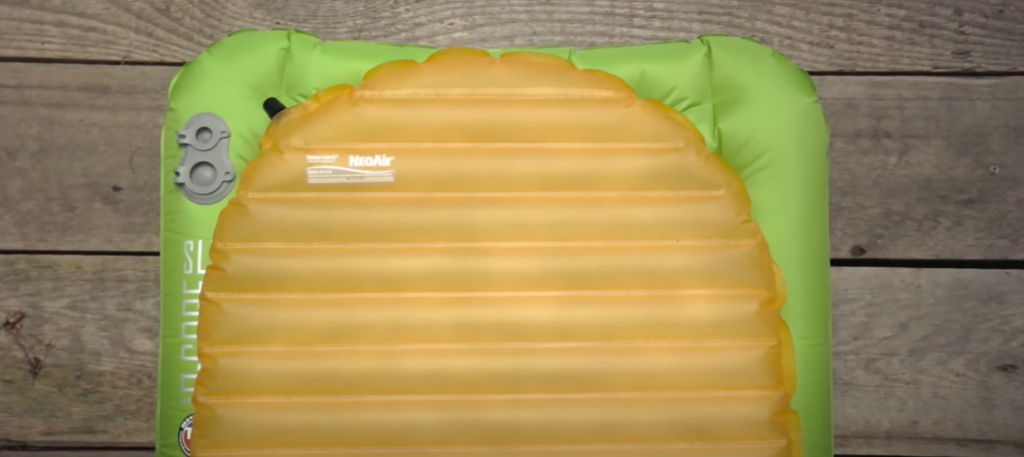
Campsite Setup Tips
Site selection and preparation
When setting up your tent, it’s essential to choose the right location and prepare the site properly for optimal comfort. Firstly, avoid setting up camp on uneven or rocky terrain as these surfaces can be uncomfortable and may even damage your tent floor. Instead, look for a flat, smooth area with natural cushioning such as grass or pine needles.
Additionally, pay attention to any potential hazards around your campsite, such as low-hanging branches or ant hills. These can be easily avoided by clearing the area and removing any debris before pitching your tent. Take a moment to assess the surrounding trees and ensure there are no dead branches that could pose a risk during high winds.
Furthermore, consider the direction of the wind when positioning your tent. Placing the entrance facing away from the prevailing wind can help minimize drafts and ensure a more pleasant sleeping experience. Additionally, if you anticipate rain, try to set up your tent on slightly elevated ground to avoid potential pooling of water.
Remember to bring along a groundsheet or tarp to provide an extra layer of protection against moisture from the ground. This can help keep the interior of your tent dry and comfortable throughout your camping adventure. With these additional details in mind, you can ensure a well-prepared and enjoyable camping experience.[2]
Tent organization for a cozy atmosphere
A well-organized tent not only enhances the overall comfort of your sleeping space but also creates a cozy and inviting atmosphere. To achieve this, consider dividing your tent into designated areas for sleeping, storage, and lounging. This way, you can have separate spaces for each activity, allowing for better organization and ease of movement within the tent.
In addition to the practical aspects of organizing your tent, don’t forget to add some personal touches to your sleeping area. Bringing along a cozy blanket or a string of fairy lights can instantly transform your sleeping space into a warm and inviting sanctuary. Imagine snuggling up under the soft glow of fairy lights, creating a peaceful and relaxing ambiance that allows you to unwind after a long day of outdoor activities.[2]
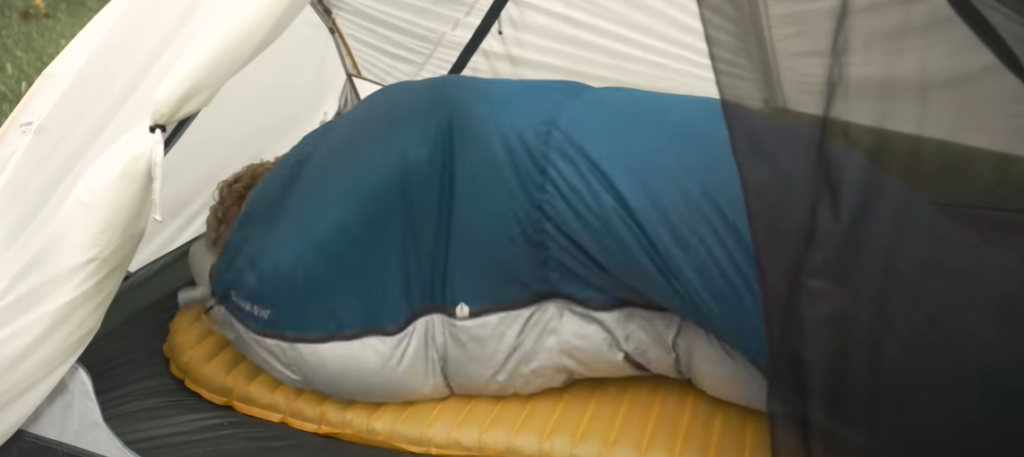
Minimizing noise and disturbances
When camping in the great outdoors, it’s not uncommon to encounter noise and disturbances from neighboring campsites or wildlife. These disruptions can sometimes hinder the tranquility of your camping experience. To minimize these potential distractions, consider selecting a campsite that is situated away from large groups and high traffic areas. This way, you can enjoy a more secluded and peaceful environment.
In addition to choosing a suitable campsite, there are a few other measures you can take to further enhance your camping experience. For instance, using earplugs and an eye mask can prove to be beneficial in blocking out any unwanted noise and light, ensuring a more restful and uninterrupted sleep.
Furthermore, implementing designated “quiet hours” within your own camping group can greatly contribute to a serene atmosphere. By encouraging everyone to wind down and refrain from engaging in loud conversations or activities during these specified hours, you can create an environment conducive to relaxation and rejuvenation. It’s important to remember to be considerate of other campers as well, keeping noise levels to a minimum during these designated quiet hours.[2]
Sleeping Positions and Techniques
Finding the perfect sleeping position
One of the key factors to a comfortable night’s sleep in a tent is finding the right sleeping position. For most people, this may mean experimenting with different positions until they find what works best for them. However, there are a few general guidelines that can help you achieve a more comfortable sleeping position.
For instance, it’s often recommended to sleep on your back or side rather than on your stomach to avoid any strain on your neck or back. Additionally, using a pillow or rolled-up clothing under your head can provide added support and increase comfort levels.
If you’re someone who tends to shift around in their sleep, consider investing in a sleeping bag with a built-in sleeve for your sleeping pad. This helps keep the sleeping pad in place, preventing it from sliding around while you sleep.[4]
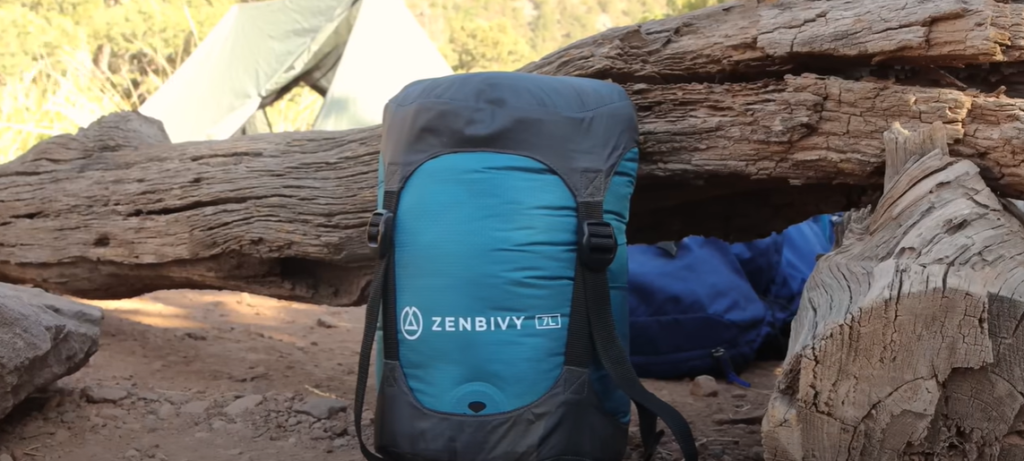
Tips for staying warm in cold conditions
Sleeping in a tent during colder temperatures can be challenging, but there are ways to stay warm and cozy throughout the night. Firstly, make sure to bring along appropriate sleeping gear such as a sleeping bag with a lower temperature rating than the expected nighttime temperature. Consider using a sleeping bag liner for added warmth and insulation.
You can also place blankets or extra layers of clothing underneath your sleeping bag for added insulation against the cold ground. Additionally, wearing a hat and keeping your head covered can help retain body heat.
Another helpful tip is to eat a warm meal or drink a hot beverage before bed. This not only provides nourishment but also warms up your body from the inside out. And finally, make sure to properly ventilate your tent to avoid condensation and moisture buildup, as this can make you feel colder while sleeping.[4]
Staying cool in hot weather
On the other hand, sleeping in a tent during hot weather can also present its own set of challenges. To stay cool and comfortable throughout the night, consider positioning your tent in a shaded area to minimize exposure to direct sunlight. This will help create a cooler microclimate inside the tent. You can also invest in a tent with good ventilation, such as one with mesh panels or windows, to promote airflow and allow hot air to escape.
Additionally, wearing lightweight and breathable clothing can make a significant difference in regulating body temperature while sleeping. Opt for moisture-wicking fabrics that can help evaporate sweat and keep you dry. It’s also a good idea to bring a small portable fan that runs on batteries or a rechargeable power source to create a gentle breeze inside the tent.
Lastly, if you want to take your camping comfort to the next level, consider using a camping cot or hammock instead of an air mattress or sleeping directly on the ground. Elevating yourself off the ground allows for better airflow and can provide a cooler sleeping experience. Plus, it can also help keep you away from any potential moisture or critters that may be on the ground.[4]
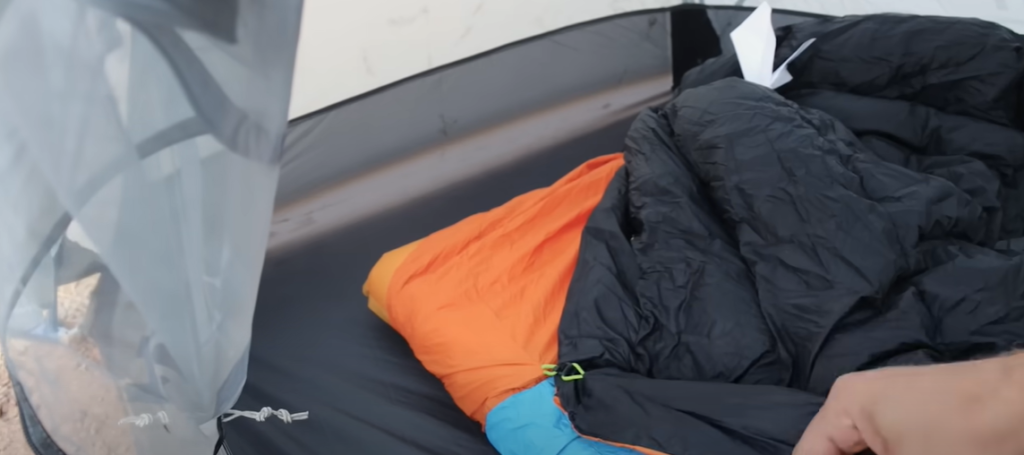
Campfire Cooking for a Good Night’s Sleep
- Eating a well-balanced meal
When camping, it’s important to prioritize eating a nutritious and well-balanced meal. Not only does it provide the sustenance your body needs, but it also contributes to a good night’s sleep, ensuring you wake up refreshed and ready for the day’s activities.
To ensure you have enough energy for your outdoor adventures, make sure to pack a variety of food items that will supply your body with the necessary nutrients. Consider including protein-rich options like nuts, jerky, and canned meats, which provide essential amino acids for muscle repair and growth. Don’t forget to include a selection of fruits and vegetables to provide vitamins, minerals, and fiber to support overall health and digestion.
In addition to the nutritional benefits, cooking over a campfire can enhance the overall camping experience. Gathering around the fire, roasting marshmallows, and cooking meals together with your fellow campers create a sense of togetherness, fostering a spirit of community and relaxation. So, don’t forget to pack your favorite recipes and cooking utensils to fully enjoy this delightful aspect of camping.
- When it comes to maintaining a good sleep routine, it’s advisable to steer clear of heavy or greasy meals in the hours leading up to bedtime. This is because such meals can lead to discomfort and hinder your ability to fall asleep peacefully and quickly.
- A tidy and organized cooking area is not only a matter of hygiene but also plays a crucial role in keeping unwanted pests away from your campsite. It’s essential to dispose of any food scraps properly and ensure that your hands are thoroughly washed before and after handling food. By following these practices, you can create a clean and safe environment for your cooking adventures.[1]
Wind-Down Rituals for a Restful Night’s Sleep
- Unwinding with a book or music
As the day comes to an end, it’s important to establish a wind-down routine that can help prepare your mind and body for sleep. Reading a book, listening to calming music, or doing some light stretching are all great ways to relax and unwind before bed.
- Limiting screen time
The blue light emitted from electronic devices can disrupt your body’s natural sleep cycle, making it harder to fall asleep. Limiting screen time before bed and using a blue light filter on your devices can help promote better sleep.
- Practicing deep breathing or meditation
Incorporating deep breathing exercises or meditation into your wind-down routine can also aid in relaxation and promote better sleep. Focus on taking deep breaths and clearing your mind of any worries or stressors.
By implementing these tips and techniques, you can create a more comfortable and restful sleeping experience while camping in a tent. Remember to prioritize relaxation and considerate behavior towards others to ensure a peaceful night’s sleep for everyone in your camping group.[1]

FAQ
Is it good to sleep in a tent?
There are various factors to consider when determining if sleeping in a tent is a good option for you. Some people find it uncomfortable and prefer other forms of accommodation, while others enjoy the experience and find it more budget-friendly. Ultimately, it depends on personal preference and the specific circumstances of your camping trip. However, with proper preparation and following helpful tips, sleeping in a tent can be a comfortable and enjoyable experience.
Which way round do you sleep in a tent?
There is no one right way to sleep in a tent, as it ultimately depends on individual preference. Some people prefer sleeping with their head towards the door for easier access, while others may prefer having their head away from the entrance for more privacy. Additionally, you can also consider factors such as airflow and avoiding direct sunlight when deciding on the best orientation for your sleeping position in a tent.
What is the best position for a tent?
The best position for a tent is on flat ground, away from potential hazards such as falling branches or uneven terrain. It’s also advisable to set up the tent in an area with good airflow and shade during the day to keep the interior cooler. Additionally, consider setting up your tent near natural features like trees or bushes that can provide additional shelter and privacy. However, the best position for a tent ultimately depends on personal preference and the specific circumstances of your camping trip.
Is it cold to sleep in a tent?
It can be cold to sleep in a tent, especially during colder seasons or at higher elevations. However, with proper preparation and gear, you can create a warm and comfortable sleeping environment inside the tent. Investing in a good quality sleeping bag rated for colder temperatures, using insulating sleeping pads, and wearing appropriate clothing while sleeping can all help keep you warm and cozy throughout the night. Additionally, choosing a campsite with natural wind barriers and good sun exposure can also help regulate the temperature inside your tent. Overall, proper preparation and gear are crucial in ensuring a warm and comfortable sleep while camping in a tent.
How do you stay safe in a tent?
To stay safe while camping in a tent, it’s essential to choose a suitable campsite and set up your tent correctly. Look for flat ground free of potential hazards like rocks or tree roots, and avoid setting up your tent in low-lying areas that may be prone to flooding. Additionally, make sure your tent is secured properly and follows correct safety guidelines. It’s also important to have a first aid kit and emergency supplies on hand in case of any unforeseen circumstances. Finally, following fire safety regulations and keeping your camping area clean and organized can also help ensure a safe camping experience in a tent.
Useful Video: The KEY to Great Sleep Outdoors
Conclusion
Camping in a tent can be a fun and memorable experience, but it’s essential to prioritize comfort and safety for a restful night’s sleep. From choosing the right campsite to setting up your tent properly, following helpful tips and techniques can greatly enhance your camping experience. Remember to also maintain good hygiene and considerate behavior towards others while camping in a shared space. With proper preparation, a positive attitude, and some helpful wind-down rituals, you can create a comfortable and enjoyable sleeping experience in a tent. So go ahead, explore the great outdoors, and sleep soundly under the stars on your next camping trip! Happy camping!
References:
- https://wildernessredefined.com/most-comfortable-way-to-sleep-in-a-tent/
- https://foxtrail.fjallraven.com/articles/10-tips-for-getting-your-best-nights-sleep-in-a-tent
- https://www.themanual.com/outdoors/how-to-sleep-in-a-tent-comfortably/
- https://topnotchoutdoor.com/most-comfortable-ways-to-sleep-in-a-tent/


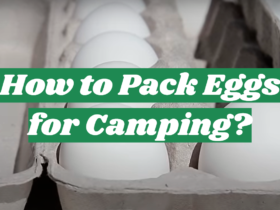


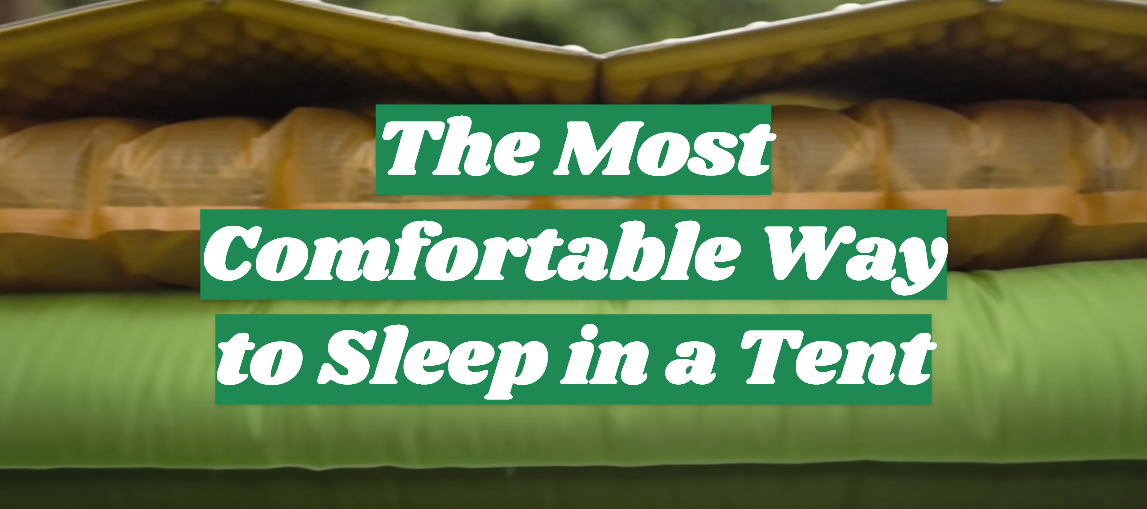

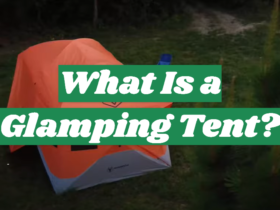
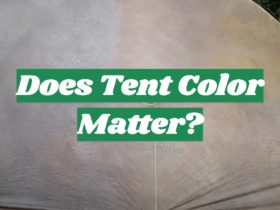
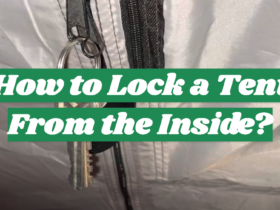
Leave a Review